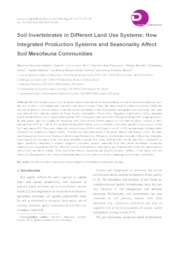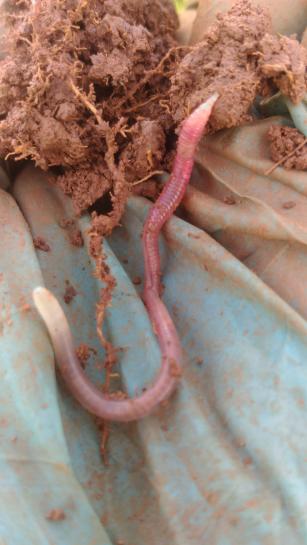Soil invertebrates in different land use systems: how integrated production systems and seasonality affect soil mesofauna communities.
Soil invertebrates in different land use systems: how integrated production systems and seasonality affect soil mesofauna communities.
Autoria: ZAGATTO, M. R. G.; NIVA, C. C.; THOMAZINI, M. J.; BARETTA, D.; SANTOS, A.; NADOLNY, H.; CARDOSO, G. B. X.; BROWN, G. G.
Resumo: Abstract: The soil mesofauna plays a role in organic matter comminution and decomposition, and can be used as bioindicators, since they are sensitive to soil management, vegetation and climate changes. Hence, this study aimed to evaluate mesofauna density and diversity in different land use systems to identify faunal relationships with soil properties, management and seasonality. The study area included five land use systems in Ponta Grossa municipality, Paraná State: integrated crop-livestock (ICL), integrated crop-livestock-forestry (ICLF), grazed native pasture (NP), Eucalyptus dunnii plantation (EU) and no-tillage (NT) cropping systems. In each system, eight soil samples for mesofauna were collected with Berlese funnels of 8 cm diameter along a transect in three replicate plots of 50 m × 100 m. For physical and chemical analysis, soil was sampled at five points per plot in two seasons: winter 2012 and autumn 2013. Data were statistically analyzed using ANOVA and Duncan?s test (P < 0.05), nonparametric statistics (when necessary) and redundancy analysis (RDA). Diversity was calculated based on the group richness and Simpson index. The main mesofauna groups found were: Acarina, Collembola and Hymenoptera. Diplopoda, Enchytraeidae, Isopoda, Collembola, Hemiptera, Hymenoptera and Coleoptera larvae were more abundant in autumn than winter. Soil moisture was the main factor responsible for higher mesofauna abundance in autumn. Integrated production systems, especially ICLF had similar invertebrate community abundance and composition with EU, while NT favored Oribatid mites, although the use of insecticides, herbicides and fungicides reduced total mesofauna density. Most correlations between mesofauna and physical-chemical attributes in the winter were not observed in the autumn and vice versa, revealing that there are more factors involved in regulating soil mesofauna distribution.
Ano de publicação: 2017
Tipo de publicação: Artigo de periódico
Unidade: Embrapa Cerrados
Palavras-chave: Animal Invertebrado, Biodiversidade, Bioindicador, Manejo do Solo, Umidade do Solo, Variação Sazonal
Observações
1 - Por padrão são exibidas publicações dos últimos 20 anos. Para encontrar publicações mais antigas, configure o filtro ano de publicação, colocando o ano a partir do qual você deseja encontrar publicações. O filtro está na coluna da esquerda na busca acima.
2 - Para ler algumas publicações da Embrapa (apenas as que estão em formato ePub), é necessário ter, no celular ou computador, um desses softwares gratuitos. Sistemas Android: Google Play Livros; IOS: iBooks; Windows e Linux: software Calibre.
Acesse outras publicações
Acesse a Base de Dados da Pesquisa Agropecuária (BDPA) para consultar o acervo completo das bibliotecas da Embrapa.


